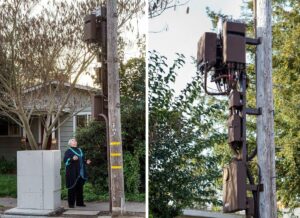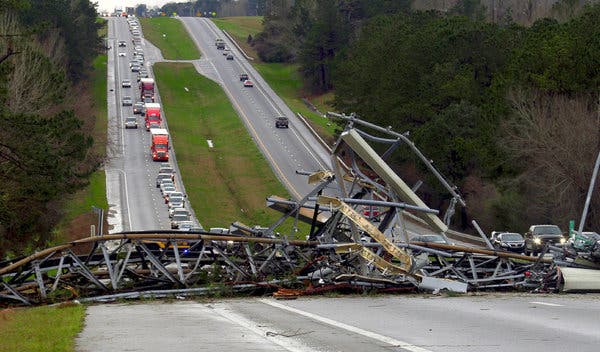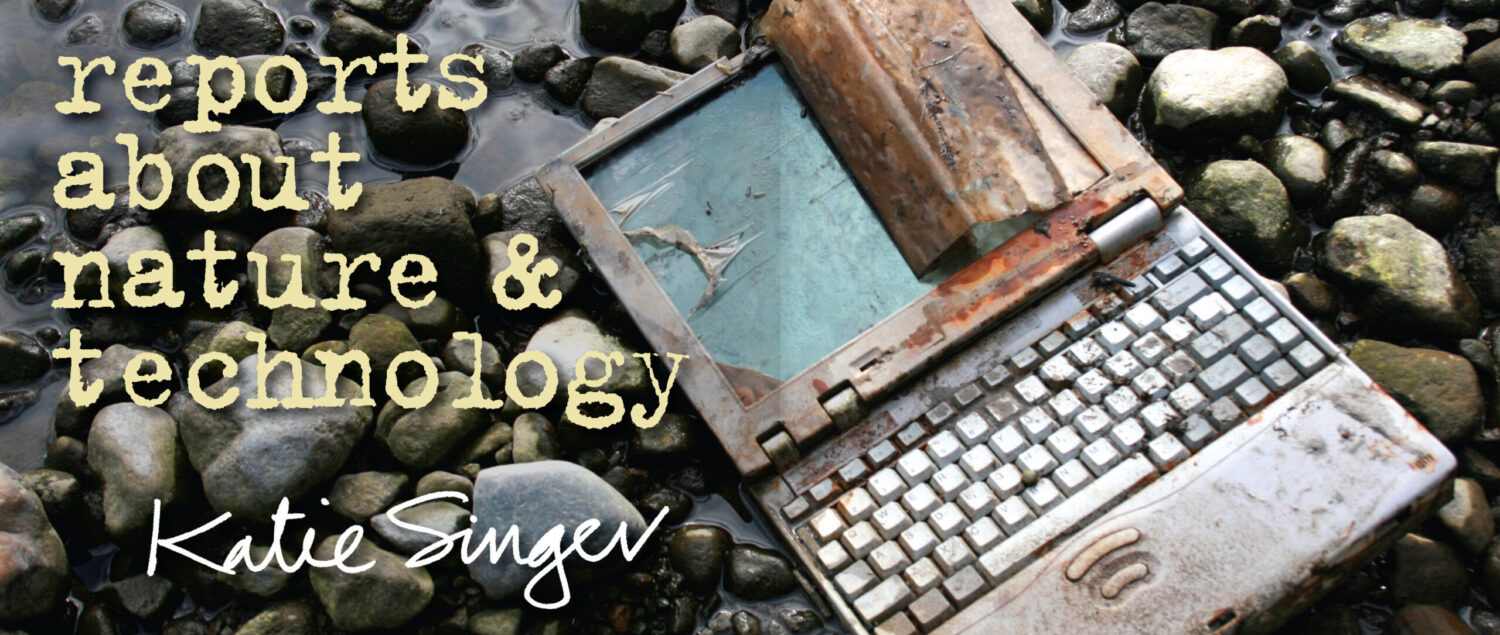Who decides whether or not 5G is safe to deploy?
A protocol for ensuring safer infrastructure
by Katie Singer

In Santa Rosa, California, a cell site was installed on the utility pole without neighborhood notification in January, 2018.
Photo credit: https://mystreetmychoice.com
In the Fall of 2018, my City Council held a public hearing before it voted on an ordinance that would effectively allow telecom corporations to install cellular antennas (i.e., 5G small cell sites) on public rights-of-way as they deem fit. Before the vote, about 30 citizens spoke. Most people opposed the ordinance, referencing scientific studies that show that legally allowed levels of electromagnetic radiation (EMR) emitted by antennas on utility poles close to residences would likely harm public health and wildlife.
The councilors largely ignored these comments. In 1996, perhaps because the telecom industry aimed to deploy infrastructure for mobile networks no-matter-what, the U.S. Congress passed the Telecommunications Act (TCA); its Section 704 states that a municipality cannot deny a permit to install new telecom equipment “on the basis of the environmental effects of radio frequency (RF) emissions” if the Federal Communications Commission’s RF limits are met. (Similar laws were enacted internationally.) In legal challenges to Section 704, several U.S. Circuit Courts interpreted the word “environmental” to include health. The TCA also states that if it is believed that a municipality denies a telecom permit based on environmental (or health) concerns, then the telecom company can sue that city.
Indeed, the TCA’s Section 704 puts municipal leaders—who likely do not want their city sued by a telecom corporation—in a bind.
About a year before my city council’s meeting, I had begun to learn about electrical equipment’s fire hazards. During my two minutes at the podium, I noted that our city had endured unusually high winds the previous spring. “Will a professional engineer evaluate each utility pole and certify that it can safely hold hundreds of pounds of electronic gear, including in high winds?” I asked. “Will a professional engineer certify that each cell site’s fire and collapse hazards have been mitigated? Also, in the event that a cell site on a public right-of-way does collapse and/or catch fire, who will be liable—the telecom corporation, the municipality or the property owner?”
A man who spoke after me—who supported 5G’s deployment—referred to my questions and nearly shouted, “Come on! Cellular sites are not new technology!”
When the citizen-comment period ended, our city attorney went to the podium. “Councilors,” he said. “In regard to Ms. Singer’s questions, we trust the telecom companies.”
The ordinance passed.
I began collecting photos about cell towers that have collapsed and caught fire.1 I also wondered what I could have done differently to help my city enact a safer telecom ordinance.
Who decides?
When corporations want to deploy 5G and market billions of new devices to go with it, who decides whether or not the new technology is safe?
What qualifies the experts who make decisions? Do they prioritize wildlife and public health—or corporate profit and technological developments? Do deciders look at the technology’s impacts from its cradle-to-grave? Do they look from its cradle-to-7th generation?
What do the experts’ evaluations entail? Do they provide forums to hear and research citizens’ questions about 5G’s safety and ecological impacts? Do they hold licenses? Do they hold liability for their reports?
Defining “experts”
Say that an expert is trained to evaluate and mitigate hazards of new (and existing) technologies—and holds a license and liability for their reports. In the U.S., state-credentialed subject-matter experts on safety are called professional engineers (PEs). A PE’s report (about the safety of a substation, a mobile network, a water treatment facility, a bridge or condo building’s structural integrity, for examples) demonstrates comprehensive evaluation and certification (a seal) about whether or not all hazards have been mitigated. To ensure safety, before any project gets a permit to go live, a PE’s sealed report is necessary.
The electrical PE I know was trained to think that nothing is safe until it’s proven safe. With each new layer of infrastructure, he has basic engineering questions: Is it safe? Have the advantages and hazards of this technology over the next 30 years been thoroughly evaluated and mitigated? Where’s the PE’s report? What does the report say?
Let me be clear here: While I may have excellent questions, I am not an expert in telecom infrastructure. Neither is my city attorney.
Correcting the paradigm on safety
To date, people who question the safety of mobile devices and telecom infrastructure have had to prove that these technologies are not safe. Telecom proponents—merchants of doubt—have succeeded in promoting the idea that research about EMR-exposure is inconclusive or unavailable;2 and, therefore, mobile networks and devices are safe enough for international deployment. Despite thousands of studies demonstrating harm from exposure to electromagnetic radiation (EMR) emitted by devices and telecom infrastructure,3 efforts to prove that mobile technologies are not safe have largely failed.
In a reversal of this trend, in August, 2021, the U.S. Court of Appeals/District of Columbia ruled that the Federal Communications Commission must explain why it ignored scientific evidence showing harm to children from wireless radiation.4 Effectively, this ruling requires the FCC and telecom providers to prove that mobile networks and devices are safe for children.
Meanwhile, few people have questioned telecom equipment’s fire and collapse hazards.
If our society aims for safety, we need a paradigm correction. We need to quit requiring people who question the safety of telecom equipment to prove that it’s not safe. We need municipalities to require corporations to prove that their proposed installations are safe.
To ensure safety

Cell tower fire
caused by improper welding
near Heritage High School.
Newport News, VA, Jun 16, 2015
http://wtkr.com/2015/06/16/cell-phone-tower-near-heritage-high-school-catches-fire/
Source: WTKR3
To ensure safety, before issuing a permit to install 5G small cell sites (or any electrical infrastructure) municipalities that prioritize safety must require an independent PE’s report showing that:
- the five hazards that The National Fire Protection Association recognizes regarding use of electrical equipment (electrical contact, thermal effects, overcurrent, fault current and overvoltage) have been evaluated and mitigated.
- a structural PE has evaluated and mitigated the equipment’s collapse hazards.
- the hypothesis presented in April, 2021 at the California Conference of Arson Investigators—that RF emissions can break down PVC insulation on electrical wiring and lead to arcing and fire—has been mitigated.5
- during a power outage, phones will work.
- EMR exposure’s effects on children have been mitigated.
- Telecom products and services must be accessible to people with disabilities.6
One more item: Shouldn’t every cell site post signage in letters large enough to read from a distance to warn roofers, electricians and tree pruners (for examples) to keep a safe distance from the antennas? The sign should provide the number of an agency that can quickly turn the antennas off so that workers can work safely, without dangerous exposure to electromagnetic radiation.
A Protocol for Ensuring Electrical Equipment Safety

Cell tower felled by tornado
across U.S. Route 280.
Smiths Station, Lee County, AL, March 3, 2019
https://www.nytimes.com/2019/03/03/us/tornado-alabama-georgia-deaths.html
Photo credit: Mike Haskey/Ledger-Enquirer, via Associated Press
In April, 2021, Malibu, California enacted an ordinance that corrects the paradigm on installing safer telecom equipment: it requires a professional engineer’s report that all hazards on new telecom installations have been mitigated before any permit is granted.7 Any municipality that prioritizes safety can enact an ordinance like this one, a protocol that reinforces the assumption that no electrical equipment—including cellular antennas, smart meters, Wi-Fi systems, solar arrays—is safe until it is proven safe. No permit is granted until a state-credentialed subject matter expert who holds a license and liability provides a sealed report showing that all hazards have been evaluated and mitigated.
Today, if my city attorney announced that “we trust the telecom companies” regarding cell site installations, I would politely repeat, “Show us the documentation. Show us the professional engineer’s certified report that all hazards have been evaluated and mitigated. Your decision could imperil your constituents’ life, health and property. Show us the PE’s sealed report that proves this equipment’s safety.”
References
- www.OurWeb.tech/fires-and-collapses
- Mark Hertsgaard and Mark Dowie, “How Big Wireless Made Us Think That Cell Phones are Safe”The Nation, 2018. https://www.thenation.com/articlearchive/how-big-wireless-made-us-think-that-cell-phones-are-safe-a-special-investigation
- www.saferemr.com; www.bioinitiative.org
- EHT et al. v. FCC, documents numerous violations of federal laws and demonstrates how the FCC did not provide evidence of having undergone a “hard-look” or systematic assessment of the scientific evidence. Download EHT’s printable factsheet on EHT et al.v. FCC court ruling
- https://www.ourweb.tech/CCAI-presentation.pdf
- https://www.fcc.gov/consumers/guides/telecommunications-access-people-disabilities
“FCC rules under Section 255 of the Communications Act require telecommunications equipment manufacturers and service providers to make their products and services accessible to people with disabilities, if such access is readily achievable. Where access is not readily achievable, manufacturers and service providers must make their devices and services compatible with peripheral devices and specialized customer premises equipment that are commonly used by people with disabilities, if such compatibility is readily achievable.“ - https://www.malibucity.org/1040/Wireless-Communication-Facilities
Katie Singer writes about the energy, extractions, toxic waste and greenhouse gases involved in manufacturing computers, telecom infrastructure, electric vehicles and other electronic technologies. She believes that if she’s not aware that she’s part of the problem, then she can’t be part of the solution. She dreams that every smartphone user learns about the supply chain of one substance (of 1000+) in a smartphone. Her most recent book is An Electronic Silent Spring. She currently writes about nature, democracy and technology for Meer.com. Visit www.OurWeb.tech and www.ElectronicSilentSpring.com.
This article was originally published by Meer.com.
